LONDON ROAD (NORTH) TRAIL
LONDON ROAD TRAIL
London Road

London Road starts its journey south from the Spot, where Osmaston Road and St Peter’s Street meet. In 1738, a Turnpike Trust was set up by parliament, authorised to collect tolls, in return for maintaining the road to London. This considerably improved the speed of movement between Derby and the Capital.
The importance of London Road grew to Derby people and those travelling from the south, with the arrival of the railways in the town. Access to the railway station was facilitated with the building of Midland Road in 1840.
In 1880, Derby Tramway Company opened up a route from the Marketplace to the Midland Station and extended it to Deadman’s Lane the following year. It was largely a single track with passing loops at intervals. Derby Corporation took over the Tramway Company in 1899. Five years later the London Road route was converted to electric operation and horse trams ran for the last time in Derby in 1907.
Cosmo Restaurant (St Peter’s Quarter)
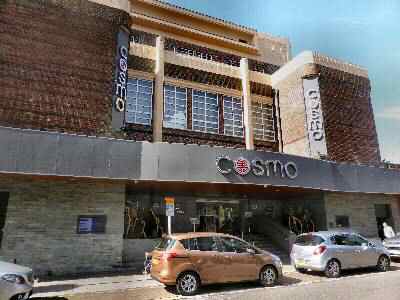
Built in 1934 as the Gaumont Cinema, Derby’s first super-cinema, it opened on 17 September that year. It was very popular with young people who apart from watching the films, enjoyed listening to the very distinctive Compton organ before it was sold to St Philip’s Church, Chaddesden. In 1965, it became the Odeon and later the Trocadero and was finally known as the Cannon, when it closed its doors for the last time in December 1988. In recent years, it was regarded as one of the best nightclubs in the Midlands, with a capacity of 2,820. It is now a Pan Asian and World Banquet Dining Restaurant.
Liversage Almshouses
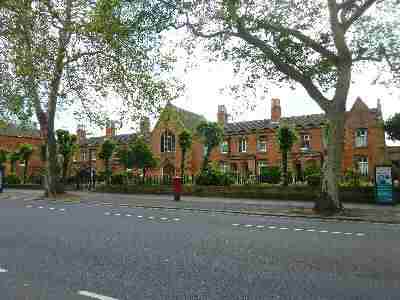
Further along London Road, shortly after crossing the Inner Ring Road, the Liversage Trust Almshouses are located. They were built out of part of the proceeds of the Liversage estate. Robert Liversage, a master dyer and tradesman, had become very wealthy during the first half of the 16th century but died a childless man in 1529. Together with his wife, they left all their land and property to the poor of St Peter’s Parish, where they lived and worshipped. This led to the establishment of the Liversage Charity Trust, the value of which increased enormously over the years.
In 1836, Derby architect John Mason designed 21 almshouses with a chapel and hospital along London Road. The houses had a front room, small kitchen, pantry, one-bedroom and lavatory with gardens at the rear and a lawn at the front. The occupants were provided with coal and a coat or cloak each year. All the occupants were given a shilling a week to live on, but only parishioners who had not received any other parish relief and were of the ‘best moral character’ were allowed to live in the houses.
The vicar and churchwardens had the task of selecting the elderly male and female inhabitants from St Peter’s Parish to occupy the almshouses. At first, the trustees were drawn exclusively from St Peter’s Parish, but the area of responsibility was widened in the 18th and 19th centuries to take in citizens from other parts of the town with business experience.
Florence Nightingale statue
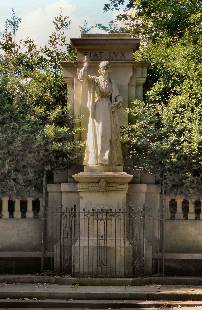
The statue of Florence Nightingale is situated on the grounds of the former DRI, facing London Road. It was the measures she took to save the injured during the Crimean War that made her famous and, she became a legend in her lifetime. Born in Italy on 12 May 1820, she was named Florence after the city where she first drew breath. On returning to England, the Nightingales divided their time between two homes at Lea Hurst in Derbyshire and Embley in Hampshire. Social life did not satisfy Florence and to the family’s dismay, she expressed the desire to take up nursing.
After many passionate arguments, she eventually got her way and despite the continuing opposition of her family, she took up an appointment as manager of the Institution for the Care of Sick Gentlewomen in Distressed Circumstances in London. It was not long after this that she went to Crimea and became a legend – the Lady with the Lamp, whose shadow the sick soldiers kissed as she passed through the wards. On returning to England, Florence devoted the rest of her life to improving public health and providing proper training for nurses.
At the age of 87, she was awarded the Order of Merit, the first woman ever to receive the award. However, she did not forget her connections with Lea Hurst setting up a reading room in Holloway and providing books there and to Lea Primary School. For the sick, she obtained the services of a doctor. She died in retirement in Buckinghamshire in 1910. The Duke of Devonshire unveiled Florence Nightingale’s statue at the DRI, on 12 June 1914.
On the other side of London Road at number one Trinity Street, the Nightingale Home used to be situated. It was associated with the Royal Derby and Derbyshire Nursing Institution. The nursing home was also a training school for midwives and district nurses. The area is now being redeveloped.
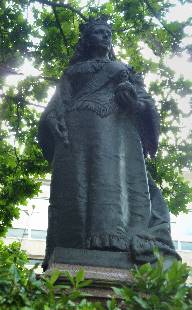
Queen Victoria Statue
King Edward VII visited Derby to unveil the statue of his mother, Queen Victoria, on 28 June 1906. The bronze statue donated by the famous Derby Engineer, Sir Alfred Seale Haslam was originally located at The Spot. However, in 1925 it was moved to the grounds of the former Derby Royal Infirmary. Queen Victoria made her only state visit to Derby in 1891 when she laid the foundation stone of the new Derbyshire Royal Infirmary, and during her visit knighted the Mayor, Alderman Alfred Seale Haslam at Derby Railway Station.
Derby Royal Infirmary(later London Road Hospital)
In 1806, a public subscription was opened in Derby to build a hospital that was to be known as the Derbyshire General Infirmary. A site was chosen off London Road close to the town centre. It was slightly elevated and for that reason dry and it also had a good supply of water readily available. William Strutt, a descendant of Jedediah the famous industrialist, incorporated many revolutionary designs into the new hospital. These included a hot air plant for heating and ventilation and numerous other labour-saving devices. As a result, the hospital was considered one of the most advanced of its time.
Unfortunately, it was discovered that the ventilation ducts could not be properly cleaned and were in fact causing disease. This led in the 1860s to an above-average death rate and as no solution could be found, Florence Nightingale advised that the hospital should be rebuilt.
In 1891, Queen Victoria laid the foundation stone for the new hospital. It enabled a request to be made for the hospital to be awarded ‘Royal’ status. This was granted and the hospital became the Derbyshire Royal Infirmary. Designed by Hall and Young of London, it was opened three years later. The hospital continued to grow and with increasing traffic on the roads after the First World War and the resultant increase in accident referrals, a causality department was added. An extension was also started in 1936 and in 1972 a new frontage was completed.
Hospital facilities have now been moved from the western side of Derby to the Royal Derby Hospital at Mickleover. It is the second-largest hospital in the East Midlands and is one of the largest hospitals in the UK. The former DRI site is being redeveloped mainly for housing.
Holy Trinity Church
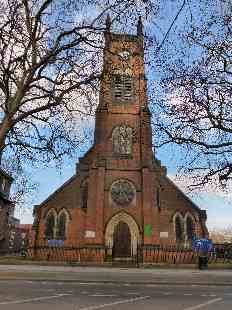
The church was founded in 1836 and was originally a chapel at ease to St Peter’s Church, in the centre of Derby, licensed for baptisms and burials. Eleven years later it was awarded full parochial status. Worship continued until 1972 when the parish united with Christ Church, on Normanton Road, Derby and the London Road Church was closed.
In 1973, the church was saved from demolition. When it was purchased by the Assemblies of the firstborn which had been established in the 1960s. The first meeting of the new church was held in the front room of a house in Upper Dale Road, Derby, under the inspirational leadership of their Minister, Thomas Cooper. As the number of people attending the fellowship grew, the decision was made to hire a hall on Osmaston Road for services. A further move was made as the congregation expanded and a former bakery on St James Street was purchased. Finally, as the church continued to expand, the former Holy Trinity Church was purchased.
Queen’s Hall
The Queen’s Hall was founded in 1861, as a Wesleyan Methodist Chapel to serve an area that had expanded rapidly following the arrival of the railways. The chapel soon became an important community centre for the east end of Derby and was renamed Queen’s Hall Methodist Mission. The manse next to the chapel was replaced by the Queen’s Chambers. In total the complex had more than 100 rooms, including three halls as well as the church. In 1927 it also had a school with places for over 1,000 pupils.
During the Second World War, a bomb fell on Canal Street destroying the rear corner of the building. It was rebuilt, but in the 1960s a structural fault was found that was so severe it could have led to the front part of the building collapsing into London Road. The problem was solved by building an impressive curved yellow brick frontage. Most of the beautiful interior of the church was rebuilt in 1991 following a fire. It was finally decided to close the mission in 2012 and it remained empty until acquired by an enterprising businessman who turned it into a banqueting and conference centre.

The eye-catching 18-foot high blue cross, the larger of two that used to adorn the front of the former mission has been removed to the Kings Way Church, Burton. Following an appeal in the Derby Telegraph by the owner of the London Road building to find a home for the crosses, he was contacted by the Burton Church. The cross was wanted to replace an old one on their church, which had become very tired-looking over the years. Transportation was something of a problem, but that was solved. When several volunteers came forward who part wheeled and partly carried the cross from Derby to its new home as part of its Easter remembrance and celebrations.
The Crown and Cushion
Occupying a prominent corner position at the junction of Midland Road with London Road is the Crown and Cushion Public House. Only a short distance from the Derby Midland Railway Station, it was built in 1853, no doubt to benefit from the boom created by the arrival of the railways. From the time the first railway train steamed into Derby in 1839, swarms of thirsty workers started arriving in the town. Arthur Cecil Felix, the grandfather of Richard Felix the recent owner of Derby Heritage Centre, was the landlord during the Edwardian era. Richard Felix is also a former star of the popular Sky TV programme, ‘Most Haunted’ and currently leads ghost and heritage walks in Derby. The pub is now closed.
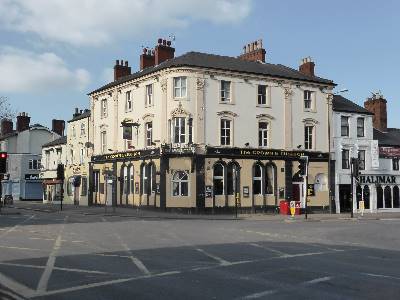
The impressive building on the opposite side of the road, on the corner of Regent Street, was built in 1903. It served for a time as a Salvation Army hostel. It is now known as Magee Court and contains a mix of purpose-built and converted flats. There are local connections with the founding of the Salvation Army; in the War Memorial Gardens at Ashbourne is a bust of Catherine Mumford, who was born in 1829, in a small terraced house in town. She married William Booth and helped him set up the Salvation Army.
Site of St Andrew’s Church
A short distance south along London Road is the site where St Andrew’s Church used to stand before it was demolished in 1970 and replaced by St Andrew’s House. The church was always regarded as the Railwaymen’s Church and dominated the skyline of London Road. The Midland Railway contributed generously towards its building costs to ensure that the spiritual needs of its ever-growing workforce were met. The foundation stone was laid in 1864, and it was consecrated two years later, but it took another 25 years before the spire was finally completed. Sir George Gilbert Scott, who designed London’s St Pancras Station, was the designer.
The church bore a striking resemblance to Christchurch Cathedral, New Zealand, which was also designed by Scott. Following severe damage by successive earthquakes in New Zealand, the Anglican Church decided to demolish, but this was strongly opposed. Since, August 2013, worship has been conducted elsewhere.
